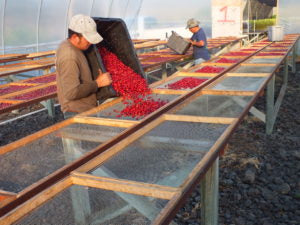How Hula Daddy Produces Karen J Red Bourbon
 In 2010, we planted an arabica coffee variety called Red Bourbon on our Waiono Farm at 2200 ft ASL We planted from seed that we picked ourselves. It took one year in the nursery and three years in the ground to create a commercial crop. Today, it is one of our most popular coffees. In 2014, Karen J won the Kona Coffee Festival Cupping Competition as the best Kona Coffee. In 2015, it won the Hawaii Coffee Association Cupping Competition as the best Kona Coffee and the best Hawaiian Coffee. This coffee is still young and we think it will continue to improve.
In 2010, we planted an arabica coffee variety called Red Bourbon on our Waiono Farm at 2200 ft ASL We planted from seed that we picked ourselves. It took one year in the nursery and three years in the ground to create a commercial crop. Today, it is one of our most popular coffees. In 2014, Karen J won the Kona Coffee Festival Cupping Competition as the best Kona Coffee. In 2015, it won the Hawaii Coffee Association Cupping Competition as the best Kona Coffee and the best Hawaiian Coffee. This coffee is still young and we think it will continue to improve.
Picking We only pick the fruit when it turns red. Coffee made with under ripe (yellow) or overripe (brown) beans is sour and astringent. We have to pay our pickers more for only picking red fruit because the picking is slower.
Sorting In the evening after picking, we put the coffee fruit on a table and sort it by hand. We throw out any fruit that isn’t red or has been damaged.
Pulping Immediately after sorting the beans, we separate the fruit from the beans by running them through a mechanical pulper. We dry the fruit to make Hula Daddy Kona Coffee Tea.
Washing After pulping the beans still have a natural sugar coating around them, that we need to remove. The beans go from the pulper into a water bath. If the natural sugars are left on the bean they mute the coffee flavors. Removing the sugar coating improves the bright, crisp taste of the roasted coffee.
We leave the freshly pulped beans in the water bath overnight. As the beans soak in the water the natural enzymes on the beans begin a fermentation process that makes the sugar coating soluble in water.
Most coffee washing in Kona ends after the first wash. However, we use a three stage wash. In the morning after the beans have been in the first wash, we drain the beans and then put them in another fresh water bath. We leave them in the bath for an additional 12 hours. At the end of the second day, we drain the beans again and put them in a third fresh water bath. By the third wash, the beans are clean and free of any sugar coating. If they are not clean, we put them in a final 24 hour bath.
Sun Drying After washing, we put the beans on wire racks in the sun to dry. They start with about 60% moisture. We want to dry them down to between 9 and 12 % moisture. In hot weather it take about 3 to 4 days to dry them. We like sun drying because we believe that there are positive chemical changes in the beans that are created by the ultraviolet and infrared rays from the sun.
Finish Drying We don’t finish drying the beans in the sun. Once the beans are below 20% moisture we put them in a mechanical dryer. We found that finishing in a mechanical dryer gives us a more even moisture content, which improves the roasting.
Resting After drying we put the beans in large sacks and let them rest for at least 60 days. Resting seems to even out the moisture in the beans and improves the roasting,
Hulling After resting there is still a parchment coating over the green beans. We send the beans to a dry mill where they take off the parchment coating and sort out any bad beans.
Roasting After all of these steps there are ready for our roaster, Laura, to do her magic. Each tree produces about 7 pounds of coffee cherry, which by the time we go through all of the above steps turns into one pound of Karen J Red Bourbon.

